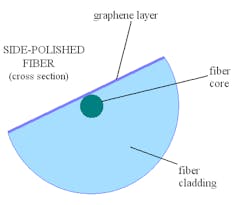Broadband graphene polarizer is ideal for integrated photonic circuits
Singapore--A sheet of graphene placed on the flat of a side-polished optical-fiber section can serve as an excellent broadband polarizer; the configuration would also work well on waveguides in integrated photonic circuits. The polarizer was created by researchers at the National University of Singapore.1
Extremely broadband polarization
The graphene was grown by chemical vapor deposition on the side-polished optical fiber. A 2.1-mm-long section of monolayer graphene was contacted with the side-polished portion of the fiber. For monochromatic light, the polarization extinction ratio for the device was 13.9 dB at a 488 nm wavelength, 14.2 dB at 532 nm, 18.3 dB at 980 nm, 15.7 dB at 1,300 nm, 18.4 dB at 1,480 nm, and 23.6 dB at 1,550 nm. For broad wavelength bands, the extinction ratio was about 15 dB at 820 to 955 nm and about 19 dB at 1,530 to 1,630 nm.
The research team that created the device was led by Kian Ping Loh at the National University of Singapore. The broadband nature of the polarizer means that it could provide an all-in-one approach for multiple-channel high-speed optical communications, the researchers said.
"In the near future, we can envision ultrathin graphene-based photonic circuits with multiple functions of light creation, routing, modulation, or detection," said Qiaoliang Bao, the project leader.
REFERENCE:
1. Qiaoliang Bao et al., Nature Photonics (2011); doi:10.1038/nphoton.2011.102.
Subscribe now to Laser Focus World magazine; it’s free!
About the Author
John Wallace
Senior Technical Editor (1998-2022)
John Wallace was with Laser Focus World for nearly 25 years, retiring in late June 2022. He obtained a bachelor's degree in mechanical engineering and physics at Rutgers University and a master's in optical engineering at the University of Rochester. Before becoming an editor, John worked as an engineer at RCA, Exxon, Eastman Kodak, and GCA Corporation.

